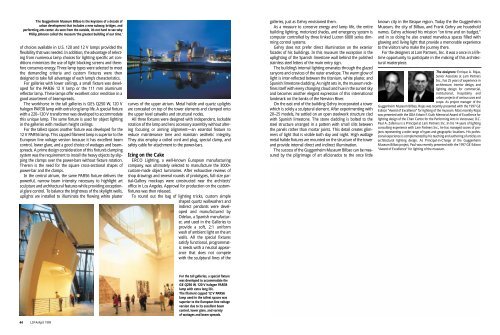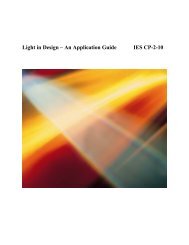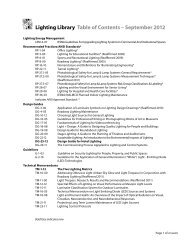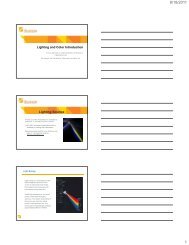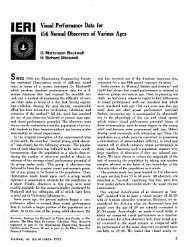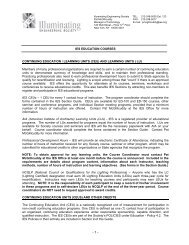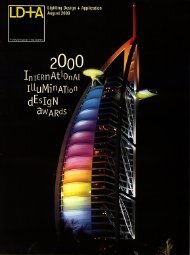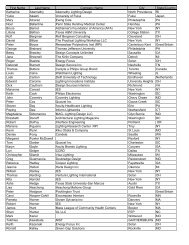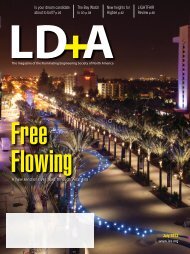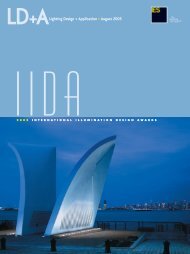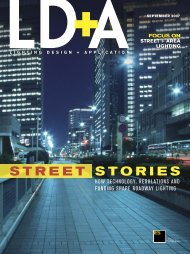lightfair international - Illuminating Engineering Society
lightfair international - Illuminating Engineering Society
lightfair international - Illuminating Engineering Society
Create successful ePaper yourself
Turn your PDF publications into a flip-book with our unique Google optimized e-Paper software.
The Guggenheim Museum Bilbao is the keystone of a decade of<br />
urban development that includes a new subway, bridges, and<br />
performing arts center. As seen from the outside, it’s not hard to see why<br />
Philip Johnson called the museum ‘the greatest building of our time.’<br />
of choices available in U.S. 120 and 12 V lamps provided the<br />
flexibility that was needed. In addition, the advantage of selecting<br />
from numerous lamp choices for lighting specific art conditions<br />
minimizes the use of light blocking screens and therefore<br />
conserves energy. Three lamp types were selected to meet<br />
the demanding criteria and custom fixtures were then<br />
designed to take full advantage of each lamp’s characteristics.<br />
For galleries with lower ceilings, a small fixture was developed<br />
for the PAR36 12 V lamp or the 111 mm aluminum<br />
reflector lamp. These lamps offer excellent color rendition in a<br />
good assortment of beamspreads.<br />
The workhorse in the tall galleries is GE’s Q250 W, 120 V<br />
halogen PAR38 lamp with extra long lamp life. A special fixture<br />
with a 220–120 V transformer was developed to accommodate<br />
this unique lamp. The same fixture is used for object lighting<br />
in the galleries with medium height ceilings.<br />
For the tallest spaces another fixture was developed for the<br />
12 V PAR56 lamp. This capped filament lamp is superior to the<br />
European line voltage version because it has excellent beam<br />
control, lower glare, and a good choice of wattages and beamspreads.<br />
A prime design consideration of this fixture’s clamping<br />
system was the requirement to install the heavy objects by slipping<br />
the clamps over the power-bars without fixture rotation.<br />
Therein is the need for the square cross-sectional shapes of<br />
power-bar and the clamps.<br />
In the central atrium, the same PAR56 fixture delivers the<br />
powerful, narrow beam intensity necessary to highlight art<br />
sculpture and architectural features while providing exceptional<br />
glare control. To balance the brightness of the skylight wells,<br />
uplights are installed to illuminate the flowing white plaster<br />
curves of the upper atrium. Metal halide and quartz uplights<br />
are concealed on top of the tower elements and clamped onto<br />
the upper level catwalks and structural nodes.<br />
All three fixtures were designed with independent, lockable<br />
rotation of the lamp and lens accessory assembly without altering<br />
focusing or aiming alignment—an essential feature to<br />
reduce maintenance time and maintain aesthetic integrity.<br />
They also employ a coiled cord and plug, special clamp, and<br />
safety cable for attachment to the power-bars.<br />
Icing on the Cake<br />
ERCO Lighting, a well-known European manufacturing<br />
company, was ultimately selected to manufacture the 3000+<br />
custom-made object luminaires. After exhaustive reviews of<br />
shop drawings and several rounds of prototypes, full-size partial-Gallery<br />
mockups were constructed near the architects’<br />
office in Los Angeles. Approval for production on the customfixtures<br />
was then released.<br />
To round out the bag of lighting tricks, custom simple<br />
shaped quartz wallwashers and<br />
indirect pendants were developed<br />
and manufactured by<br />
Odelux, a Spanish manufacturer,<br />
and used in the Galleries to<br />
provide a soft, 2:1 uniform<br />
wash of ambient light on the art<br />
walls. All the special fixtures<br />
satisfy functional, programmatic<br />
needs with a neutral appearance<br />
that does not compete<br />
with the sculptural lines of the<br />
galleries, just as Gehry envisioned them.<br />
As a measure to conserve energy and lamp life, the entire<br />
building lighting, motorized shades, and emergency system is<br />
computer controlled by three linked Lutron 6000 series dimming<br />
control systems.<br />
Gehry does not prefer direct illumination on the exterior<br />
facades of his buildings. In this museum the exception is the<br />
uplighting of the Spanish limestone wall behind the polished<br />
stainless steel letters of the main entry sign.<br />
The building’s internal lighting emanates through the glazed<br />
canyons and crevices of the outer envelope. The warm glow of<br />
light is inter-reflected between the titanium, white plaster, and<br />
Spanish limestone cladding. As night sets in, the museum redefines<br />
itself with every changing cloud and hue in the sunset sky<br />
and becomes another elegant expression of this <strong>international</strong><br />
landmark on the banks of the Nervion River.<br />
On the east end of the building Gehry incorporated a tower<br />
which is solely a sculptural element. After experimenting with<br />
20–25 models, he settled on an open steelwork structure clad<br />
with Spanish limestone. The stone cladding is bolted to the<br />
steel structure arranged in a pattern with small slits between<br />
the panels rather than mortar joints. This detail creates glimmers<br />
of light that is visible both day and night. High wattage<br />
metal halide fixtures are mounted on the structure of the tower<br />
and provide internal direct and indirect illumination.<br />
The success of the Guggenheim Museum Bilbao can be measured<br />
by the pilgrimage of art aficionados to the once little<br />
known city in the Basque region. Today the the Guggenheim<br />
Museum, the city of Bilbao, and Frank Gehry are household<br />
names. Gehry achieved his mission “on time and on budget,”<br />
and in so doing he also created marvelous spaces filled with<br />
glowing and living light that provide a memorable experience<br />
to the visitors who make the journey there.<br />
For the designers at Lam Partners, Inc. it was a once in a lifetime<br />
opportunity to participate in the making of this architectural<br />
masterpiece.<br />
The designers: Enrique A. Rojas,<br />
Senior Associate at Lam Partners<br />
Inc., has 25 years of experience in<br />
architecture, interior design, and<br />
lighting design for commercial,<br />
institutional, hospitality and<br />
urban projects of various uses and<br />
scope. As project manager of the<br />
Guggenheim Museum Bilbao, Rojas was recently presented with the 1997 GE<br />
Edison “Award of Excellence” for lighting of the museum. Most recently Rojas<br />
was presented with the IIDA Edwin F. Guth Memorial Award of Excellence for<br />
lighting design of the Chan Centre for the Performing Arts in Vancouver, B.C.<br />
Paul A. Zaferiou is a Principal at Lam Partners Inc. In his 14 years of lighting<br />
consulting experience with Lam Partners Inc., he has managed scores of projects<br />
representing a wide range of types and geographic locations. His professional<br />
experience is complemented by his teaching and authoring of articles on<br />
architectural lighting design. As Principal-in-Charge of the Guggenheim<br />
Museum Bilbao project, Paul was recently presented with the 1997 GE Edison<br />
“Award of Excellence” for lighting of the museum.<br />
For the tall galleries, a special fixture<br />
was developed to accommodate the<br />
GE Q250 W, 120 V halogen PAR38<br />
lamp with extra long life.<br />
The filament capped 12 V PAR56<br />
lamp used in the tallest spaces was<br />
superior to the European line voltage<br />
version due to its excellent beam<br />
control, lower glare, and variety<br />
of wattages and beam spreads.<br />
44 LD+A/April 1999


